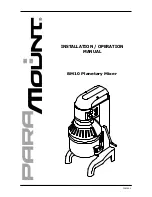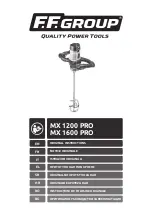
13
IMER INTERNATIONAL S.p.A.
SPIN 15
9. INSTALLATION
Position the mixer on a flat surface in a suitably ventilated
environment where it does not constitute an obstruction either
during use or cleaning at the end of the work shift.
- Position the mixer on a flat surface or slightly inclined towards
the material outlet.
10. CONNECTIONS
10.1 ELECTRICAL CONNECTION (see fig.5)
- Ensure that the power supply voltage, mains
frequency and electrical connection (socket, fuses, cable)
correspond to specifications in table 1.
The electrical power socket must be fitted with protection
against current overload (e.g. by means of fuses or a thermal
magnetic cut-out) and against dispersion current to earth (e.g.
with a differential circuit breaker). The electric cable wire size
must take into account the operating currents and length of the
line to avoid excessive voltage drops.
Avoid use of extension leads wound on drums. The power
cable must be suitable for frequent movements and with an
abrasion resistant sheath
(e.g. type H07RN-F).
Before connecting the mixer to the electrical mains, ensure that
all safety devices are fitted and are in perfect condition, and
check in particular that the hopper grid is secured in place, that
the extension in good condition and that the plugs and sockets
are not wet.
Connect the mixer socket on the electrical panel to the mains
(fig.5).
7. MECHANICAL SAFETY (see fig.1)
The hazardous points on the IMER mixer are protected by means
of suitable safety devices, which must remain fitted at all times
and kept in perfect condition. For example, this includes the
electric motor cooling fan guard and the hopper grid (ref. 10) to
prevent contact with the auger.
Also, release of the mixing chamber, shuts down all rotary parts
of the machine immediately thanks to a specific safety device.
8. TRANSPORT (see fig.2 and fig.3)
- CAUTION! Before moving the mixer, always detach
the power plug.
Before moving the mixer, disconnect the water supply hose.
Only a minimal amount of the material should be in the hopper
when handling.
Lift the mixer by means of the relative handles (fig.2)
and push in the required direction.
-CAUTION! Before lifting the mixer, always check that all
machine components are correctly secured and fitted in
place and no objects have been left on the surface
- CAUTION! Lift with care to avoid hazardous oscillations
- CAUTION! Never use points other than as specified in
figure 3 to lift the machine
To lift the machine, use the four specific attachment rings (fig.3).
FIG. 5
FIG. 3
A B
B A
FIG. 4
FIG. 2
FIG. 2
MAX
1
2
3














































